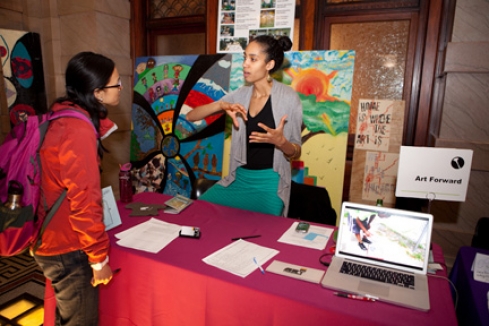Leveraging Investments in Creativity (LINC) was launched in early 2003 in New York City, with $2 million in start-up funding from the Ford Foundation, and subsequent investments from Paul G. Allen Family Foundation, John S. and James L. Knight Foundation, and Rockefeller Foundation. The Investing in Creativity report seeded LINC in the most direct way. The six domains of support became the scaffolding for LINC’s research and programming work, and the study’s exploration of both national themes and place-based strategies was carried forward in LINC’s commitment to pursuing change at both national and local levels. The nine case study sites became LINC’s first partners in changing the landscape of support, through its first program, Creative Communities. The study’s observation that artists must find allies outside the arts with whom to achieve their common goals shaped LINC’s actions in multiple areas. And the rigorous research on which it was founded illuminated the need for continuing a robust program of inquiry on issues of concern to artists and policymakers.
Holly Sidford served as the founding president, and was succeeded by Sam Miller, 18 months later, when Judilee Reed also joined LINC as its vice president.2 LINC quickly established a set of program priorities for its national and local work and defined core principles to guide its work overall:
LINC values artists as the shapers and carriers of cultural values—tradition-bearers, idea generators, change agents, and social entrepreneurs.
LINC values artists as an important sector of the independent workforce, who generate economic benefits for themselves and the communities in which they live.
LINC is dedicated to the development of innovative practices that serve and support artists.
LINC values activities that model inclusiveness and diversity as key opportunities in the stewardship of artists’ communities and in the development of organization staff.
LINC values community-based approaches that match local skills and knowledge with external expertise to solve problems and create opportunities.
LINC supports organizations that utilize collaborative, open-source strategies essential to the acceleration of innovation and achievement.
To ensure that artists’ viewpoints and perspectives infused its various initiatives, LINC also created an Artists’ Advisory Council. The Artist Advisors served as sounding boards and guides for both LINC and its partners. They met regularly with staff, attended LINC convenings, visited partner sites and gathered observations and ideas that helped LINC refine and improve its programming choices. Over LINC’s history, the Artists’ Advisory Council members included Paul Bonin-Rodriguez, Favianna Rodriguez, Grisha Coleman, Molly Davies, Theaster Gates, Hirokazu Kosaka, Liz Lerman, and Sekou Sundiata.
To ensure that artists’ viewpoints and perspectives infused its various initiatives, LINC also created an Artists’ Advisory Council. The Artist Advisors served as sounding boards and guides for both LINC and its partners. They met regularly with staff, attended LINC convenings, visited partner sites and gathered observations and ideas that helped LINC refine and improve its programming choices. Over LINC’s history, the Artists’ Advisory Council members included Paul Bonin-Rodriguez, Favianna Rodriguez, Grisha Coleman, Molly Davies, Theaster Gates, Hirokazu Kosaka, Liz Lerman, and Sekou Sundiata.
LINC’s ten-year lifespan demanded a quick start-up process and clear strategies for where and how to invest resources. It also meant that rather than focusing on its own organizational sustainability, LINC would seek to make long-lasting changes to the artist support infrastructure through collaborations with a widespread network of organizations and individuals.
LINC’s original program design explored ways to advance national discussion and policy change based on the six domains, while simultaneously working with the original nine sites in the Investing in Creativity study on the issues of greatest importance to each locale. At the national level, it quickly became clear that there were many areas in which LINC was unlikely to have a meaningful impact–building markets for artists’ work, for example, or creating a national technological infrastructure for information exchange. LINC’s work in the creation of national solutions ultimately centered on health care, space, research, and building knowledge networks.
Further, all of LINC’s work, local and national, elevated the importance of the country’s changing demographics and evolving aesthetic practices, and advocated for inclusive policies advancing cultural equality.

